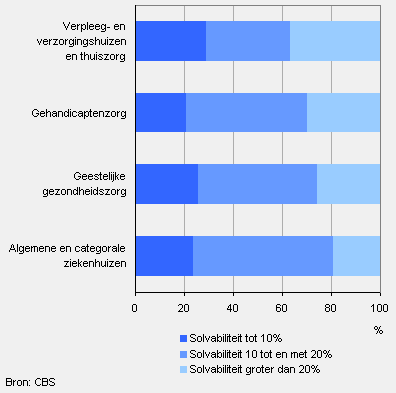Financial position care-providing institutions often precarious

The financial position of care-providing institutions is often poor in comparison to educational institutions and commercial service providers. This situation has barely improved in recent years. The financial position of more than a quarter of care institutions does not meet the criteria of the Guarantee Fund for the Care Sector.
Average solvency over the period 2006-2008 hardly improved
Despite the greater risks since the free market system was introduced in the care sector, the solvency rate has not improved markedly in 2008 relative to 2007. Solvency indicates the ability of businesses or institutions to comply with their financial obligations in case of bankruptcy. With 12 percent in 2007 and 13 percent in 2008, hospitals have the lowest solvency rate. The other care sectors performed marginally better in the range of 15 to 17 percent.
The value of net assets owned by care institutions (save university hospitals) rose by 8.3 percent to 5.8 billion euro in 2008 relative to 2007.
Average solvency position per care sector

Requirements often unattainable
The Guarantee Fund for the Care Sector guarantees bank loans for care institutions and requires a minimum solvency rate between 10 and 20 percent, depending on specific circumstances. Last year, the solvency rate of about one quarter of all care-providing institutions was below 10 percent. This group comprises the most problematic cases.
One third of institutions had a solvency rate above 20 percent last year. Most institutions varied between 10 and 20 percent. Whether this is or will be a problem depends on the circumstances. Hospitals, for example, often have collateral securities, like buildings and land plots and expensive medical equipment, putting them in a more favourable position compared to other care sectors.
Institutions per care sector by solvency, 2008

Solvency care sector low relative to educational institutions and commercial service providers
Solvency percentages in the care sector were low in 2007 relative to the sectors education (37 percent), commercial services (30 percent) and manufacturing industry and construction (65 percent). Most care and educational institutions are financed by public means and a large part of their assets consists of buildings and land, predominantly financed by these institutions. It is therefore amazing that the average solvency rate in the care sector is so much lower than in the sector education.
Average solvency rate in the care sector, the education sector and the private sector

Hilde Keuning and Karin Riksen